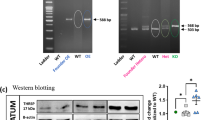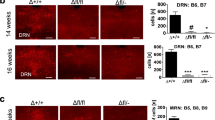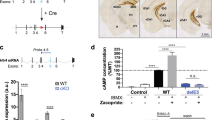Abstract
The X-linked gene STS encodes the steroid hormone-modulating enzyme steroid sulfatase. Loss-of-function of STS, and variation within the gene, have been associated with vulnerability to developing attention deficit hyperactivity disorder (ADHD), a neurodevelopmental condition characterized by inattention, severe impulsivity, hyperactivity, and motivational deficits. ADHD is commonly comorbid with a variety of disorders, including obsessive–compulsive disorder. The neurobiological role of steroid sulfatase, and therefore its potential role in ADHD and associated comorbidities, is currently poorly understood. The 39,XY*O mouse, which lacks the Sts gene, exhibits several behavioral abnormalities relevant to ADHD including inattention and hyperactivity. Here, we show that, unexpectedly, 39,XY*O mice achieve higher ratios than wild-type mice on a progressive ratio (PR) task thought to index motivation, but that there is no difference between the two groups on a behavioral task thought to index compulsivity (marble burying). High performance liquid chromatography analysis of monoamine levels in wild type and 39,XY*O brain tissue regions (the frontal cortex, striatum, thalamus, hippocampus, and cerebellum) revealed significantly higher levels of 5-hydroxytryptamine (5-HT) in the striatum and hippocampus of 39,XY*O mice. Significant correlations between hippocampal 5-HT levels and PR performance, and between striatal 5-HT levels and locomotor activity strongly implicate regionally-specific perturbations of the 5-HT system as a neurobiological candidate for behavioral differences between 40,XY and 39,XY*O mice. These data suggest that inactivating mutations and functional variants within STS might exert their influence on ADHD vulnerability, and disorder endophenotypes through modulation of the serotonergic system.
Similar content being viewed by others
Log in or create a free account to read this content
Gain free access to this article, as well as selected content from this journal and more on nature.com
or
References
Adhikari A, Topiwala MA, Gordon JA (2011). Synchronized activity between the ventral hippocampus and the medial prefrontal cortex during anxiety. Neuron 65: 257–269.
Albelda N, Joel D (2011). Animal models of obsessive-compulsive disorder: exploring pharmacology and neural substrates. Neurosci Biobehav Rev 36: 47–63.
Avale ME, Nemirovsky SI, Raisman-Vozari R, Rubinstein M (2004). Elevated serotonin is involved in hyperactivity but not in the paradoxical effect of amphetamine in mice neonatally lesioned with 6-hydroxydopamine. J Neurosci Res 78: 289–296.
Brookes KJ, Hawi Z, Kirley A, Barry E, Gill M, Kent L (2008). Association of the steroid sulfatase (STS) gene with attention deficit hyperactivity disorder. Am J Med Genet B Neuropsychiatr Genet 147B: 1531–1535.
Brookes KJ, Hawi Z, Park J, Scott S, Gill M, Kent L (2010). Polymorphisms of the steroid sulfatase (STS) gene are associated with attention deficit hyperactivity disorder and influence brain tissue mRNA expression. Am J Med Genet B Neuropsychiatr Genet 153B: 1417–1424.
Carlson CL, Booth JE, Shin M, Canu WH (2002). Parent-, teacher-, and self-rated motivational styles in ADHD subtypes. J Learn Disabil 35: 104–113.
Carola V, Frazzetto G, Pascucci T, Audero E, Puglisi-Allegra S, Cabib S et al (2008). Identifying molecular substrates in a mouse model of the serotonin transporter x environment risk factor for anxiety and depression. Biol Psychiatry 63: 840–846.
Cassano T, Gaetani S, Morgese MG, Macheda T, Laconca L, Dipasquale P et al (2009). Monoaminergic changes in locus coeruleus and dorsal raphe nucleus following noradrenaline depletion. Neurochem Res 34: 1417–1426.
Chelonis JJ, Gravelin CR, Paule MG (2011a). Assessing motivation in children using a progressive ratio task. Behav Processes 87: 203–209.
Chelonis JJ, Johnson TA, Ferguson SA, Berry KJ, Kubacak B, Edwards MC et al (2011b). Effect of methylphenidate on motivation in children with attention-deficit/hyperactivity disorder. Exp Clin Psychopharmacol 19: 145–153.
Chen K, Cases O, Rebrin I, Wu W, Gallaher TK, Seif I et al (2007). Forebrain-specific expression of monoamine oxidase A reduces neurotransmitter levels, restores the brain structure, and rescues aggressive behavior in monoamine oxidase A-deficient mice. J Biol Chem 282: 115–123.
Compagnone NA, Salido E, Shapiro LJ, Mellon SH (1997). Expression of steroid sulfatase during embryogenesis. Endocrinology 138: 4768–4773.
Cormier E (2008). Attention deficit/hyperactivity disorder: a review and update. J Pediatr Nurs 23: 345–357.
Davies W, Humby T, Kong W, Otter T, Burgoyne PS, Wilkinson LS (2009). Converging pharmacological and genetic evidence indicates a role for steroid sulfatase in attention. Biol Psychiatry 66: 360–367.
Doe CM, Relkovic D, Garfield AS, Dalley JW, Theobald DE, Humby T et al (2009). Loss of the imprinted snoRNA mbii-52 leads to increased 5htr2c pre-RNA editing and altered 5HT2CR-mediated behaviour. Hum Mol Genet 18: 2140–2148.
Doherty MJ, Glass IA, Bennett CL, Cotter PD, Watson NF, Mitchell AL et al (2003). An Xp; Yq translocation causing a novel contiguous gene syndrome in brothers with generalized epilepsy, ichthyosis, and attention deficits. Epilepsia 44: 1529–1535.
Durston S (2008). Converging methods in studying attention-deficit/hyperactivity disorder: what can we learn from neuroimaging and genetics? Dev Psychopathol 20: 1133–1143.
Eagle DM, Baunez C (2010). Is there an inhibitory-response-control system in the rat? Evidence from anatomical and pharmacological studies of behavioral inhibition. Neurosci Biobehav Rev 34: 50–72.
Fletcher PJ, Sinyard J, Higgins GA (2010). Genetic and pharmacological evidence that 5-HT2C receptor activation, but not inhibition, affects motivation to feed under a progressive ratio schedule of reinforcement. Pharmacol Biochem Behav 97: 170–178.
Geller DA (2006). Obsessive-compulsive and spectrum disorders in children and adolescents. Psychiatr Clin North Am 29: 353–370.
Gourley SL, Lee AS, Howell JL, Pittenger C, Taylor JR (2010). Dissociable regulation of instrumental action within mouse prefrontal cortex. Eur J Neurosci 32: 1726–1734.
Harrison AA, Everitt BJ, Robbins T W (1997). Doubly dissociable effects of median- and dorsal-raphe lesions on the performance of the five-choice serial reaction time test of attention in rats. Behav Brain Res 89: 135–149.
Humby T, Laird FM, Davies W, Wilkinson LS (1999). Visuospatial attentional functioning in mice: interactions between cholinergic manipulations and genotype. Eur J Neurosci 11: 2813–2823.
Kent L, Emerton J, Bhadravathi V, Weisblatt E, Pasco G, Willatt LR et al (2008). X-linked ichthyosis (steroid sulfatase deficiency) is associated with increased risk of attention deficit hyperactivity disorder, autism and social communication deficits. J Med Genet 45: 519–524.
Lonardo F, Parenti G, Luquetti DV, Annunziata I, Della Monica M, Perone L et al (2007). Contiguous gene syndrome due to an interstitial deletion in Xp22.3 in a boy with ichthyosis, chondrodysplasia punctata, mental retardation and ADHD. Eur J Med Genet 50: 301–308.
Milunsky J, Huang XL, Wyandt HE, Milunsky A (1999). Schizophrenia susceptibility gene locus at Xp22.3. Clin Genet 55: 455–460.
Nelson RJ, Trainor BC (2007). Neural mechanisms of aggression. Nat Rev Neurosci 8: 536–546.
Oades RD (2007). Role of the serotonin system in ADHD: treatment implications. Expert Rev Neurother 7: 1357–1374.
Odorisio T, Rodriguez TA, Evans EP, Clarke AR, Burgoyne PS (1998). The meiotic checkpoint monitoring synapsis eliminates spermatocytes via p53-independent apoptosis. Nat Genet 18: 257–261.
Perez-Neri I, Mendez-Sanchez I, Montes S, Rios C (2008). Acute dehydroepiandrosterone treatment exerts different effects on dopamine and serotonin turnover ratios in the rat corpus striatum and nucleus accumbens. Prog Neuropsychopharmacol Biol Psychiatry 32: 1584–1589.
Popova NK (2006). From genes to aggressive behavior: the role of serotonergic system. Bioessays 28: 495–503.
Reddy DS (2010). Neurosteroids: endogenous role in the human brain and therapeutic potentials. Prog Brain Res 186: 113–137.
Reed MJ, Purohit A, Woo LW, Newman SP, Potter BV (2005). Steroid sulfatase: molecular biology, regulation, and inhibition. Endocr Rev 26: 171–202.
Rhodes ME, Li PK, Burke AM, Johnson DA (1997). Enhanced plasma DHEAS, brain acetylcholine and memory mediated by steroid sulfatase inhibition. Brain Res 773: 28–32.
Roane HS (2008). On the applied use of progressive-ratio schedules of reinforcement. J Appl Behav Anal 41: 155–161.
Robbins TW (2002). The 5-choice serial reaction time task: behavioural pharmacology and functional neurochemistry. Psychopharmacology (Berl) 163: 362–380.
Robbins TW, Arnsten AF (2009). The neuropsychopharmacology of fronto-executive function: monoaminergic modulation. Annu Rev Neurosci 32: 267–287.
Rowles BM, Findling RL (2010). Review of pharmacotherapy options for the treatment of attention-deficit/hyperactivity disorder (ADHD) and ADHD-like symptoms in children and adolescents with developmental disorders. Dev Disabil Res Rev 16: 273–282.
Sanders AC, Hussain AJ, Hen R, Zhuang X (2007). Chronic blockade or constitutive deletion of the serotonin transporter reduces operant responding for food reward. Neuropsychopharmacology 32: 2321–2329.
Shinomiya K, Fujii Y, Sugimoto Y, Azuma N, Tokunaga S, Kitazumi K et al (2005). Effect of paroxetine on marble-burying behavior in mice. Methods Find Exp Clin Pharmacol 27: 685–687.
Singh VB, Kalimi M, Phan TH, Boadle-Biber MC (1994). Intracranial dehydroepiandrosterone blocks the activation of tryptophan hydroxylase in response to acute sound stress. Mol Cell Neurosci 5: 176–181.
Sodhi MS, Sanders-Bush E (2004). Serotonin and brain development. Int Rev Neurobiol 59: 111–174.
Stergiakouli E, Langley K, Williams H, Walters J, Williams NM, Suren S et al (2011). Steroid sulfatase is a potential modifier of cognition in attention deficit hyperactivity disorder. Genes Brain Behav 10: 334–344.
Thomas NS, Sharp AJ, Browne CE, Skuse D, Hardie C, Dennis NR (1999). Xp deletions associated with autism in three females. Hum Genet 104: 43–48.
Tobias ES, Bryce G, Farmer G, Barton J, Colgan J, Morrison N et al (2001). Absence of learning difficulties in a hyperactive boy with a terminal Xp deletion encompassing the MRX49 locus. J Med Genet 38: 466–470.
Trent S, Dennehy A, Richardson H, Ojarikre OA, Burgoyne PS, Humby T et al (2011). Steroid sulfatase-deficient mice exhibit endophenotypes relevant to attention deficit hyperactivity disorder. Psychoneuroendocrinology; e-pub ahead of print 30 June 2011; doi:10.1016/j.psyneuen.2011.06.006.
Umathe SN, Vaghasiya JM, Jain NS, Dixit PV (2009). Neurosteroids modulate compulsive and persistent behavior in rodents: implications for obsessive-compulsive disorder. Prog Neuropsychopharmacol Biol Psychiatry 33: 1161–1166.
Webster RA (2001). Neurotransmitters, drugs and brain function. Wiley.
Wilens TE, Spencer TJ (2010). Understanding attention-deficit/hyperactivity disorder from childhood to adulthood. Postgrad Med 122: 97–109.
Acknowledgements
The study was funded by a Medical Research Council United Kingdom (MRC, UK) New Investigator Grant to WD (91052), by a Research Councils UK Fellowship to WD and by grant PRIN 2009 to TC. We would like to thank Dr Silvana Gaetani in whose laboratory the neurochemical analyzes were conducted.
Author information
Authors and Affiliations
Corresponding author
Ethics declarations
Competing interests
The authors declare no conflict of interest.
Additional information
Supplementary Information accompanies the paper on the Neuropsychopharmacology website
PowerPoint slides
Rights and permissions
About this article
Cite this article
Trent, S., Cassano, T., Bedse, G. et al. Altered Serotonergic Function may Partially Account for Behavioral Endophenotypes in Steroid Sulfatase-deficient Mice. Neuropsychopharmacol 37, 1267–1274 (2012). https://doi.org/10.1038/npp.2011.314
Received:
Revised:
Accepted:
Published:
Issue date:
DOI: https://doi.org/10.1038/npp.2011.314
Keywords
This article is cited by
-
Xp22.31 copy number variations in 87 fetuses: refined genotype–phenotype correlations by prenatal and postnatal follow-up
BMC Medical Genomics (2023)
-
A new molecular risk pathway for postpartum mood disorders: clues from steroid sulfatase–deficient individuals
Archives of Women's Mental Health (2021)
-
Exploring the Validity of Proposed Transgenic Animal Models of Attention-Deficit Hyperactivity Disorder (ADHD)
Molecular Neurobiology (2017)
-
Motivational assessment of mice using the touchscreen operant testing system: effects of dopaminergic drugs
Psychopharmacology (2015)
-
Altered brain gene expression but not steroid biochemistry in a genetic mouse model of neurodevelopmental disorder
Molecular Autism (2014)



